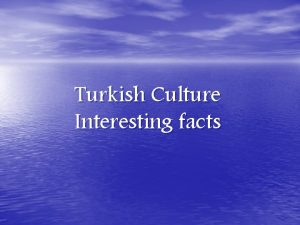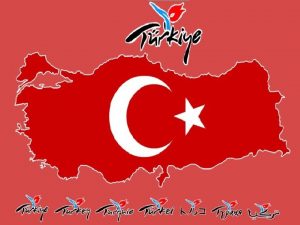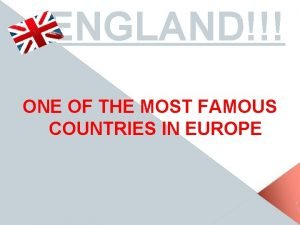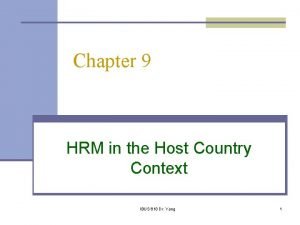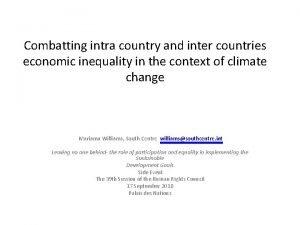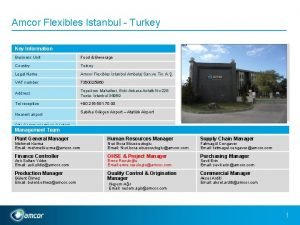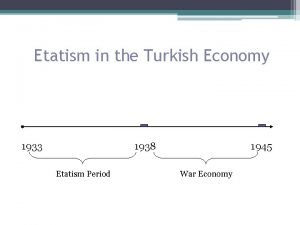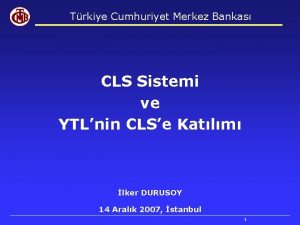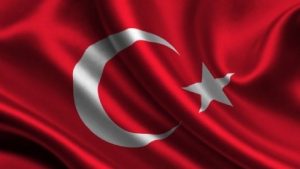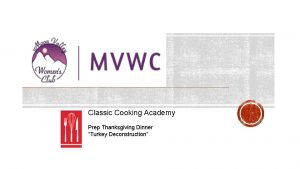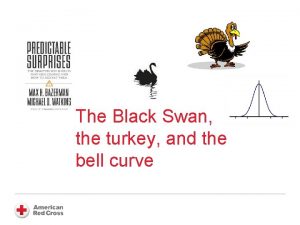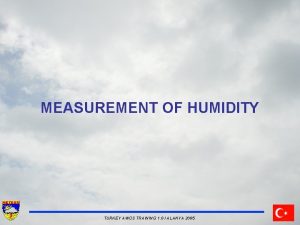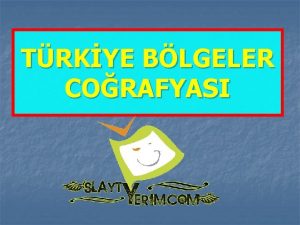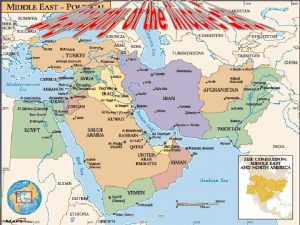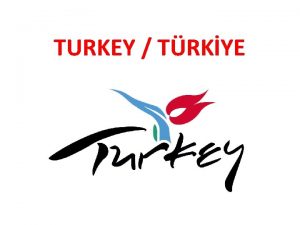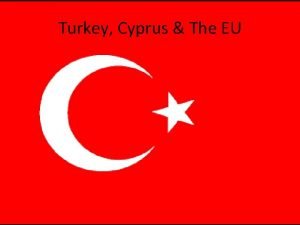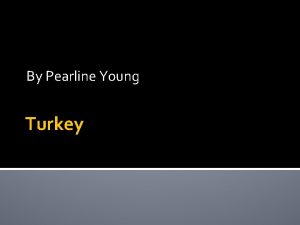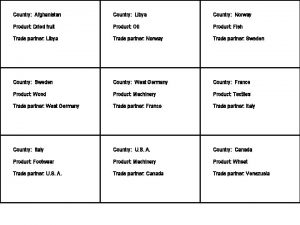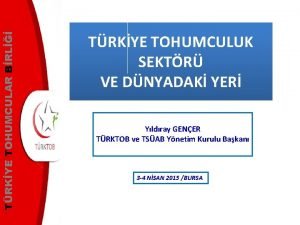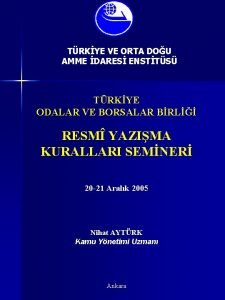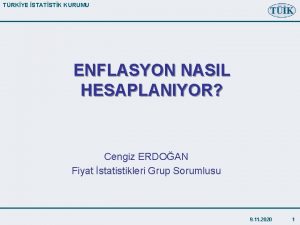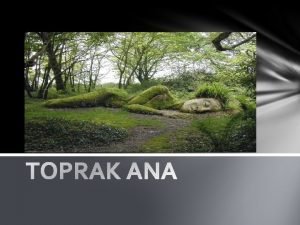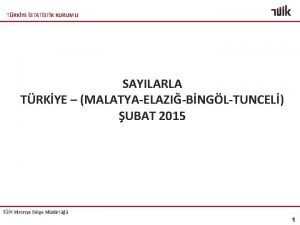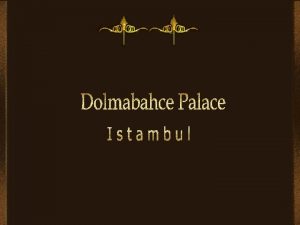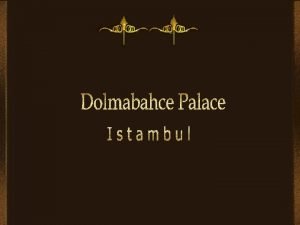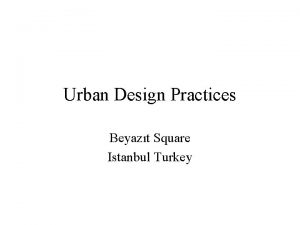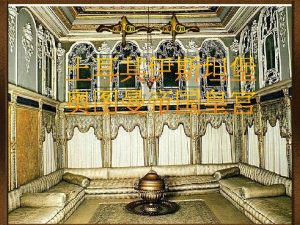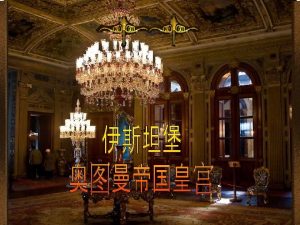TURKEY TRKYE TRKYE Turkey is a country located
























- Slides: 24

TURKEY TÜRKİYE

TÜRKİYE • Turkey is a country located at a point where three continents of the old world, Asia, Africa and Europe, are closest to each other and where Asia and Europoe meet. • Because its geographical location, Anataolia has always been important throughout history and is the birth place of many great civilizations. • Turkey is not only a passageway from which the ancient Asian Turkish Culture is transmitted to the Europe, but also counted as a window of Western Culture opening to meet the Eastern Culture.

TÜRKİYE • The surface area of Turkey including the lakes is 815. 000 km 2. It is much larger than many European countries, for examples bigger than Great Britain and France combined, Italy and Spain together. • 97 % is in Asia and this part is called Anataloia by Turks or Asia Minor in the history, 3 % is in Europe which is called Thrace, Trakya by the Turks.

TÜRKİYE • The country is divided by the Dardanelles, the sea of Marmara and the Bosphorus and surrounded with three seas, The Black Sea on the north, The Aegean on the west and Mediterrenean on the south. So it is a Big peninsula. • Turkey has boundaries with the neighbouring countries, such as Greece, and Bulgaria in the West, Armenia, Georgia, very little part of Azerbaycan and Iran in the East, Syria and Irak on the south.

TÜRKİYE Turkiye is divided into 7 geographical regions

TÜRKİYE LANGUAGE • • • The official language in Turkiye is Turkish and this is spoken about 95 % of the population. About 5 % of the Turkish people who come from different ethnic origins, speak their mother tongues in daily life besides Turkish is a branch of Ural-Altaic languages. These were originally spoken by the Altai people who lived in the steppe area around the Altai mountains which form part of the border between China, Mongolia and Russia. The Altai spread out over a vast geographical area reaching as far as the Balkans and today more than 300 million people speak Turkish from Adriatic coast to the Great Walls in China. Since 1928 Turkish has been written in a phonetic Latin Alphabet of 29 letters. With only few variations of the pronouncation is like English. For example, we use a lot of dots either on the top of letters or underneath of them to produce vowels. “ Ş, Ö, Ü, Ç, Ğ, İ”

TÜRKİYE CLIMATE • Because of the geographical formation of the country with mountains that run parallel to the coasts, Anatolia is a focal point of contrasting climates. While in the coastal areas winters are mild and summers are moderately hot, the inland areas experience extremes of temperature. • In the Mediterrenean, Agean and Southern Marmara regions, the General Mediterrenean climate is dominant; summers are hot and dry, winters are mild and rainy. Frosts are rare and snowfall is almost unknown.

TÜRKİYE CLIMATE • The Black Sea region enjoys mild winters and a fair amount of rainfall throuhgout the year. • In Central Anatolia, a typical plateau climate preveils where the summers are hot with minimum precipitation, and winters are cold with heavy and lasting snows. Villages may be isaolated by severe snowstorms. • Eastern Anatolia is rugged country with higher elevations, a more severe climate and greater precipitation than the central plateau. The climate of this region is most inhospitable Summers are hot and extremely dry, winters are bitterly cold. Spring and Autumn are both subject to sudden hot and cold spells.

TÜRKİYE ADMINISTRATION AND GOVERNMENT • The republic of Turkey is a democratic, secular and social state. • The legislative power of the Turkish Republic is the Turkish Grand National Assembly ( TGNA) which performs its function on behalf of the Turkish nation. • The TGNA was first empowerted to exercise legislative power in Ankara on April 23 rd, 1920, by Mustafa Kemal. The total numbers of the members are 550. • • The duties of the TGNA include enacting and amending laws, monitoring the actions of the Cabinet and Ministers, debating the budget, ratifying international agreements and declaring a war. Anybody above the age of 21, who has a minimum primary school education and who has a security clearence can be elected as a deputy.

TÜRKİYE ADMINISTRATION AND GOVERNMENT • Elections are held every 5 years. • According to the constitution, all Turkish citizens over 18 years of age have the right to vote in elections and to take part in referendums. • The cabinet which is politically responsible to the Legislature is composed of the Prime Minister and ministers. • After the general elections, the leader of the party winning the majority is appointed as the Prime Minister by the President. The ministers are selected by the Prime minister but again appointed by the president.

TÜRKİYE NATIONAL RESOURCES • Turkey is one of about 8 countries in the world which consistently produces surplus food and cattle for export. • Turkey is believed to be rich in a wide variety of mineral deposits which are mostly governed by the state sector. • Relatively few of these have been exploited on a large scale. This is due to a lack of domestic capital for exploration, political pressure that has discouraged wide-scale investment from abroad and inadequate processing facilities.

TÜRKİYE’S TOTAL LAND • 36 % agricultural land • 30 % forests and brushwood • 28 % grazing land • 6 % swamps, river beds, rocks and water surfaces

TÜRKİYE MILITARY SERVICE • Since the Ottoman period different systems of military service have been used at different periods. • Today, under the Military Service Law, all male citizens who are physically eligible must perform military service between the ages of 20 and 41. The compulsory service period is 15 months. • The social function of military service : Military service is a very important social event in men’s lives. It has the distinct effect of dividing it into two phases: life before and after military service. • Generally men serve in places other than their home regions without returning except for their vacations. Before leaving, the family provides a big meal in their son’s honour and invite relatives, friends and neighbours. A large group of friends escort the boy to the central bus or train station with musical instruments, usually drums and clarinets, the louder the better. They may even carry him on their shoulders •

TÜRKİYE MILITARY SERVICE • Military service is a kind of school in which the young men of Turkey reach maturity through the experiences that they live. • This is a place where they become acquainted with manners. • For some, it is the first time they live away from home. Being away from family is also an opportunity to learn to stand responsibility on their on feet. • In some rural parts of Turkey, young men cannot get married before completing their military service, since this period is accepted as a major step in the transition to manhood.

TÜRKİYE TURKISH FLAG • Beacuse of the Turkish republic was founded on the heritage of the Ottoman Empire, many things from that time, such as the Turkish Flag, continued but sometimes with slight changes. • The Ottoman used various flags of different colours at different times. In the 14 th C it was white, ın the 15 th C it was changed to red, Once it was 3 white crescents with a green background. • Each of the crescents symbolized a continent on which the Ottomans used to rule. As the Ottomans were associated with Islam, crescents might also have symbolized the sovereignty of Islam on three continents. From then on, the crescents have been known as the symbol of Islam. • Later, in the 18 th C only one crescent together with an star on red background was used. The combination of the crescent and the red colour came about, according to legend when one of the Turkish commmanders while wandering around a battlefield, noticed the reflection of a star in the blood collected on the ground. That imaged so impressed the commander that he chose the symbols for the flag. • Today, the red color is accepted as the symbol of blood. A heroic poem about the color says : “ What makes a flag is the blood and tears, and what convert a land into a nation is the martyrs. ”

TÜRKİYE CURRENCY • In Türkiye, it is used Turkish Lira as a formal currency. • It has a symbol • 1 TL is nearly 2. 25 €

TÜRKİYE TURKISH FLAG • After the foundation of the Turkish republic, the Turkish flag was chosen to be a combination of a crescent and a 5 -pointed star on a red background. • The fundamentals of the Turkish flag were laid down by the laws : Old, dirty or torn flags cannot be used. People cannot sit or step on them. • In schools or official places it is hoisted at the weekends and on holidays. On Monday mornings, the new week starts with students saluting the national flag in schools. All over the nation there are only two places in which the flag is kept permanently raised ; the first is the parliment building, because here it symbolizes the contunity of the nation’s existence, the second is the mausoleum of Mustafa Kemal Atatürk, the father of the Turks. • Only on the day of his death, November 10 th, is the flag hung half-mast as a sign of sorrow.

TURKISH EDUCATIONAL SYSTEM TÜRKİYE

TÜRKİYE TURKISH EDUCATIONAL SYSTEM • Many reforms in education were made immediately after the foundation of the republic. The most important one was the secularization. • Education has been made a top priority of national development. It has the largest budget of any ministry with an allocation of over 20 % of the national budget. The aim of the Turkish Educational system is to nurture productive, happy individuals with broad views on world affairs who will unite in national consciousness and thinking to form an inseparable state, and will contribute to the prosperity of society through their skills.

TÜRKİYE TURKISH EDUCATIONAL SYSTEM • The responsibility of executing Turkish National Education in accordance with the basic principals and in the name of the government is charged to the Ministry of National Education. • The National Education system determined by the law is executed in two main basic movements called “Normal education” and “Common education”. Normal Education is the education executed regularly under the roof of the school with the objectively prepared programs to the individuals with the determined age group and equals and includes the associatons of pre-school, primary school, high school.

TÜRKİYE TURKISH EDUCATIONAL SYSTEM • By the season for 2012 -2013, there is a reform at our educational system. It is compulsory for 12 years education for each person after completing her/his 60 months old. 4 years for primary school, 4 years secondary school, 4 years high school. • The compulsory education covers the education of the children between the ages of 6 -18 for an twelve year continous period, is obligatory for each citizen. • A special feature of primary schools is that one teacher takes care of all students in one class, from the first grade and continues with those children for four years. With the fifth year, the system of one teacher for each class changes to a specialist teacher for each subject. • The average number of students in each classroom is 25 -40, but in some rural areas, where there are not enough teachers, even more the students have to fit into the same classroom.

TÜRKİYE TURKISH EDUCATIONAL SYSTEM • The high school education covers the entire general, professional and techniqual instutitions having four-year education period and is dependent on the primary education. • Besides the delivarence of minimum common culture values, the students are prepared for the higher education where the education should be directed to their interests, skills and capacities. • Anataolian, Science, Social Science, Fine Arts and Sports, Vocational, Technical and Islamic Theological schools are different from the General High School, but are still a part of the secondary education system.

TÜRKİYE TURKISH EDUCATIONAL SYSTEM • The Higher Education consists of universities, faculties, research centers and high schools of further education which are all affiliated to an autonomous Higher Education Council. • There a total number of 166 universities including the private universities. • Students are admitted to universities through a two-phase examination held once a year. The first phase is for selection and the second for replacement. • In order to obtain a good future, students want to study in good departments at good universities. This is why they start studying for the entrance exams as much as two years in advance, generally taking private courses as well. • Generally speaking over 1, 500, 000 students per year take entrance exams, out of which 800, 000 are selected after the first phase, but approximately 500, 000 of them are actually placed in schools of further education.

TÜRKİYE THANK YOU… TEŞEKKÜRLER…
 Trkye
Trkye Facts about turkish culture
Facts about turkish culture Country that looks like a turkey
Country that looks like a turkey England is located in which country
England is located in which country What countries surround greece
What countries surround greece Sistine chapel is located in which country
Sistine chapel is located in which country Poland is located in which country
Poland is located in which country Host country and home country
Host country and home country Intra country vs inter country
Intra country vs inter country Thanksgiving fact and opinion
Thanksgiving fact and opinion Aksel arditi
Aksel arditi Turkish national anthem lyrics
Turkish national anthem lyrics Ryan gloyer middle school
Ryan gloyer middle school Etatism turkey
Etatism turkey Ilker durusoy
Ilker durusoy Tdps generator
Tdps generator Turkey capital of the world
Turkey capital of the world Sahebdin turkey
Sahebdin turkey Noahs ark ararat
Noahs ark ararat Isuzu corporate
Isuzu corporate How to deconstruct a turkey
How to deconstruct a turkey Black swan turkey
Black swan turkey Armand peugeot
Armand peugeot Humidity recorder turkey
Humidity recorder turkey Undersecretariat of treasury (turkey)
Undersecretariat of treasury (turkey)

